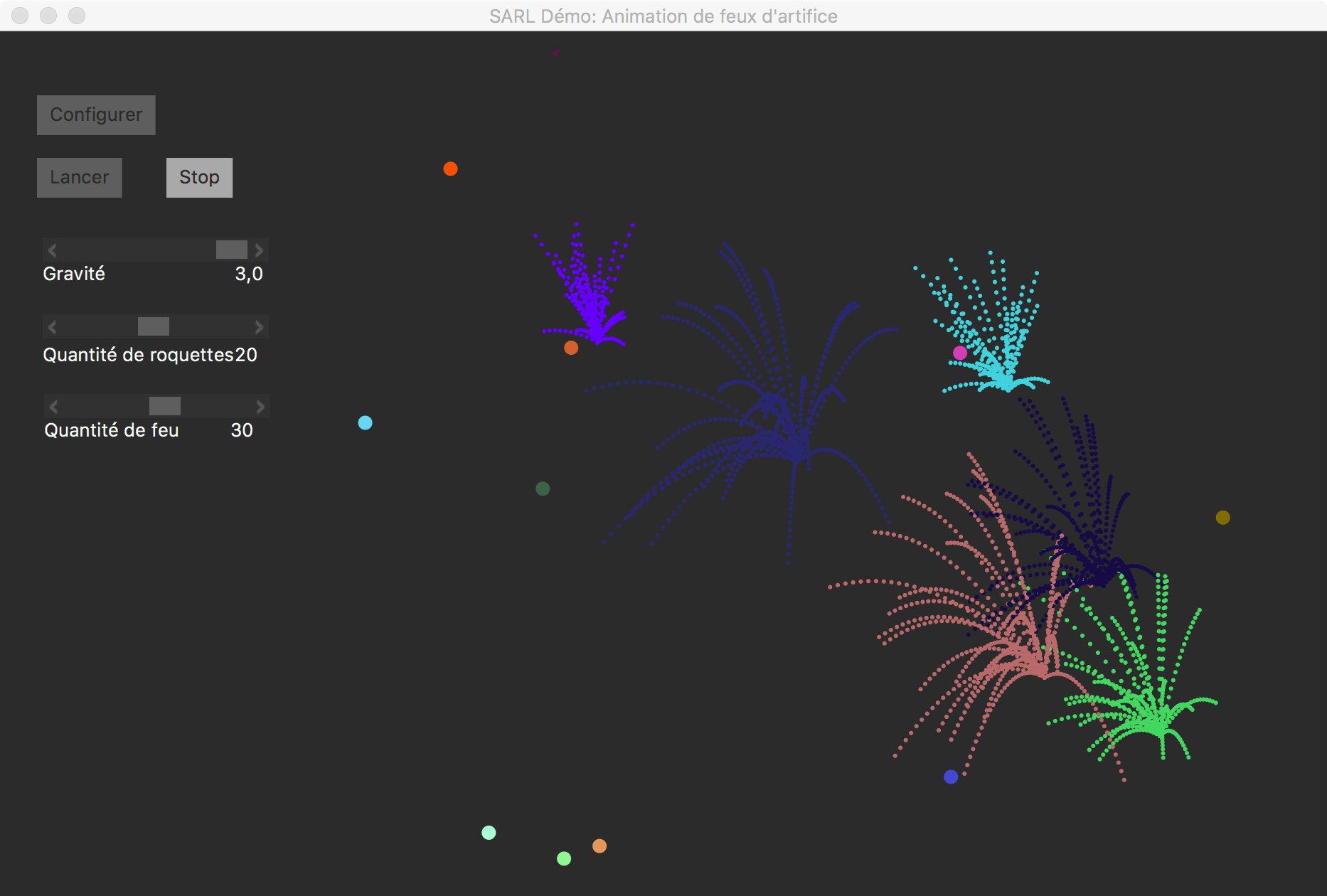
Fireworks demonstration
The goal of this demo is to bring out some fireworks using SARL agents.
Launching the demonstration
- From SARL ID:
- Create a launch configuration of type “SARL Application”
- As the main class, select
io.sarl.demos.fireworks.Fireworks
- From command-line interface:
- Launch the application as a standard Java program.
Description of the software
The application is composed of 4 agents. The whole structure is holonic.

The main agent is the LaunchingArea which is linked with the GUI and and contains the other agents inside its inner context. This agent creates the RocketLauncher, one by rocket asked by the user. It also transmits the gravity and other parameters. This agent also registers the GUI on a dedicated OpenEventSpace for communication.
agent LaunchingArea {
...
/*
* Get setup event from the GUI
*/
on SetupSettings {
this.rocketsQuantity = occurrence.rocketsQuantity
this.fireQuantity = occurrence.fireQuatity
this.gravity = occurrence.gravity
this.maxWidth = occurrence.maxWidth
}
/*
* Agent initialisation when spawned by the GUI
* A communication space is opened between
* the GUI and this agent
*/
on Initialize [!occurrence.parameters.empty] {
var ctrl = occurrence.parameters.get(0) as FXMLViewerController
var ispace = defaultContext.createSpace(
OpenEventSpaceSpecification, UUID.randomUUID)
ctrl.setGUISpace(ispace)
ispace.register(asEventListener)
ctrl.listenAndDraw(grid)
info("Finishing initialization of Launching Area")
}
...
}
Then, each RocketLauncher creates a Rocket. When this one is destroyed, the RocketLauncher is going to generate another one. This allows to displace the verification of the existence of the Rocket out of the LaunchingArea. It also isolates the Rocket and avoid that emitted events disrupt the managing of the simulation.
agent RocketLauncher {
...
/*
* A new rocket is launched when the previous
* one is destroyed
*/
on MemberLeft [!isFromMe(occurrence) && !exited] {
// wake allows to send the event at the agent itself
wake(new Launch)
}
...
}
Rocket agents are the heart of this demo. Each one create a task with a fixed delay where they updates their position by writing it in a object shared with the GUI, here named Positions. When the Rocket reach the end of its lifetime, they create Fire agent within their inner context according to the quantity asked by the user and then wait for the destruction of every Fire to kill themselves.
agent Rocket {
...
on Initialize {
...
/*
* Create a new background task to update
* the agent position at a fixed delay
*/
move = atFixedDelay(
Configuration.RocketLifeCycleSchedulingRate) [
try {
wake(new UpdateRocketPosition);
} catch (e : Exception) {
e.printStackTrace
}
]
}
on UpdateRocketPosition [isFromMe(occurrence) &&
!frozen && !exploded] {
var vect = new Vector(2)
x = x + speedx
y = y + speedy
vect.clear()
vect.add(x)
vect.add(y)
lifetime = lifetime - 10
/* Updates the Position object */
if (grid !== null)
grid.setRocketPosition(id, vect)
if (lifetime <= 0) {
exploded = true
move.cancel(true)
grid.hideHocketPosition(id)
wake(new Explode)
}
}
...
}
The Fire is the last agent of the demo. It have a list of positions and is subjected to gravity. As Rocket agent, the Fire launch a task at a fixed delay to update its actual position, add it at the end of the actual list and then update the Positions object. When its lifetime is over, the Fire is destroyed.
MVC pattern
This application follows a MVC (Model-View-Controller) pattern for the GUI communication.

When the GUI is closed, an event Exit is sent to the LaunchingArea which transmits it to the other agents she owns. It waits for their elimination to destroy the next one, until itself.
User Interface
